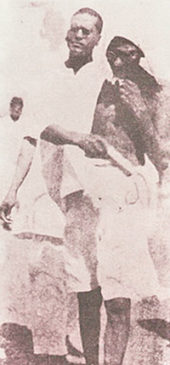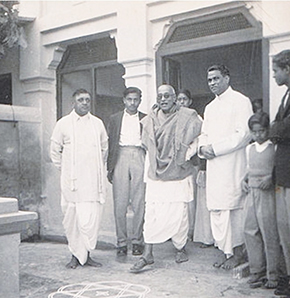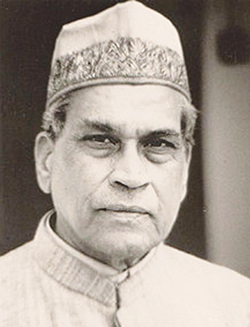History is full of stories. These stories talk about the big leaders all the time and important contributors are missed out in the process. However, the picture of the society is incomplete without the stories of the not so visible contributors. The part played by the good Samaritans who fulfil the dreams of the leaders need to be remembered. The great leaders would not have been able to execute their plans if not for the many self less souls who worked along with them. Vellalore Annaswamy Sundaram alias V A Sundaram (1896 – 1967) was one such noble Coimbatorean who did much for the Benares Hindu University those days.
Mahamahopadhyaya Pandit Madan Mohan Malaviya was responsible for the founding of BHU (Benares Hindu University) in Varanasi.  The institution has contributed much towards the well being of the nation. It was Pandit Malaviya who gave the slogan ‘Satyameva Jayate’ (Truth alone will triumph) from the Mundakopanishad as the National Slogan. He started the tradition of Aarti at ‘Har Ki Pauri’ – Haridwar to the sacred Ganga River, which is performed till date. The great leader was posthumously conferred the highest civilian title – Bharat Ratna by the Government of India. For its part, Coimbatore has named a street in Ramnagar after Pandit Malaviya. The great soul is also remembered for his role in ending the Indian indenture system, especially in the Caribbean. Malaviya’s efforts in helping the Indo Caribbean people is compared to Gandhi’s efforts connected with Indians in South Africa.
The institution has contributed much towards the well being of the nation. It was Pandit Malaviya who gave the slogan ‘Satyameva Jayate’ (Truth alone will triumph) from the Mundakopanishad as the National Slogan. He started the tradition of Aarti at ‘Har Ki Pauri’ – Haridwar to the sacred Ganga River, which is performed till date. The great leader was posthumously conferred the highest civilian title – Bharat Ratna by the Government of India. For its part, Coimbatore has named a street in Ramnagar after Pandit Malaviya. The great soul is also remembered for his role in ending the Indian indenture system, especially in the Caribbean. Malaviya’s efforts in helping the Indo Caribbean people is compared to Gandhi’s efforts connected with Indians in South Africa.
Coimbatorean V.A.Sundaram played a good role in making the dream of Pandit Malaviya a reality. He was born to Annaswamy Iyer of Vellalore.The family traced its ancestry to the famous scholar Appayya Dikshita, who belonged to the sixteenth century. His father had been an advocate. Sundaram was keenly interested in literature and poetry from his younger days.
He did his higher education at Pachaiyappas College in Chennai. He was greatly interested in English literature. Sundaram attended a meeting of Gandhi in Chennai and like many others, he was drawn towards him. He gave up his studies and became a disciple of Gandhi. The Mahatma took him to Sabarmati Ashram and Sundaram spent some time in the historic place. Sundaram returned from the ashram but he continued to follow the ideals as eschewed by Gandhi. He helped the people of Vellalore by involving them in hand spinning, weaving and crafts.
V.A.Sundaram was closely associated with Rajaji, Vijayaraghachariar and Subramania Iyer. He participated in the Vaikkom Satyagraha, Salt Sathyagraha and the non cooperation movement.
Sundaram got incarcerated in 1931 at Chennai. He began writing for a number of publications which included – Young India, The Modern Review, The Hindu, The Independent, New India, Amrita Bazaar Patrika etc.,. His essays and letters added to the healthy flavour of the freedom movement. His high ideals, patriotism and ability to deliver made him a very powerful and popular speaker. Some of his speeches were broadcast in the All India Radio.
Gandhi sent him as an ambassador for his political principles to Europe just before participating in the Round Table Conference. Sundaram spent 7 months in Europe and he met up with writers, scholars, politicians and people of wisdom during the course of his travel. He spread the principles of Gandhi during his long tour. Sundaram accompanied Pandit Malaviya to Harrow, Oxford and Cambridge. It gave him an oppourtunity to assimilate teaching and research methods. Sundaram met Mussolini and Pope Pious XI and elucidated Gandhi’s message through Giornale d’Italia. In Germany, he held public meetings in Kassel and Berlin. He met Albert Einstein and was asked to transmit a letter from him to Gandhi.
Sundaram travelled to Switzerland, France and Czeckoslovakia. He met President Masaryk in Prague. In the course of his tour, Sundaram was able to strengthen international knowledge about Gandhian philosophy and political message. In order to achieve this objective, Sundaram met Stephen Spender, Arthur Mee, Christopher Isherwood, Birger Forell, Wilfrid Israel, Piero Misciatelli, Andre Maurois, Paul Birukoff, Franziska Standenath among many others.
V.A.Sundaram visited Kasi those days and came to learn about the founding of the Benares Hindu University. He was attracted to the cause and joined the initiative on the invitation of Pandit Madan Mohan Malaviya.
Sundaram functioned as the Personal assistant of Pandit Malaviya during the formative years. He was associated with the big institution from 1926 to 1956.
 Malaviya sent Sundaram to Kotgarh in the Himalayan mountains and it was here that American Samuel Evans Stokes had set up a school. The school was in need of an English teacher and Sundaram filled the role. The American was known as Satyanand Stokes (1886 – 1946) and he had participated in the freedom movement. Stokes is best remembered today for having introduced apple cultivation to Himachal Pradesh. Satyanand Stokes was known as “An American in Khadi”. Sundaram lived in this place with his young wife Savithri. He was in close touch with Gandhi by sending him a letter every week.
Malaviya sent Sundaram to Kotgarh in the Himalayan mountains and it was here that American Samuel Evans Stokes had set up a school. The school was in need of an English teacher and Sundaram filled the role. The American was known as Satyanand Stokes (1886 – 1946) and he had participated in the freedom movement. Stokes is best remembered today for having introduced apple cultivation to Himachal Pradesh. Satyanand Stokes was known as “An American in Khadi”. Sundaram lived in this place with his young wife Savithri. He was in close touch with Gandhi by sending him a letter every week.
This would contain noble thoughts and it was preserved by Gandhi, who later gave the complete collection to him. On his return to Varanasi, Sundaram joined Malaviya in order to build up the Benares Hindu University. He began to raise money for BHU and had developed a particular aptitude for approaching and engaging high profile donors. Sundaram was the Secretary of the BHU Fund Raising Committee and became really famous. He had raised funds in lakhs those days. Sundaram had travelled through the length and breadth of India with Malaviya. Coimbatoreans had been known for raising huge sums of money for great social uses for a long time now.
Sundaram was given a house by Pandit Malaviya in the University campus and it was known as ‘Krishnakutir’. Several important guests had been his guests and they included Rajaji, Sir Akbar Hydari, Sir Mirza Ismail, Paul Brunton, Somerset Maugham, Sir C.V.Raman and K.S.Krishnan.
Gandhi performed a prayer next to the house in 1942 and Sundaram set up a memorial stone in the same spot. The freedom fighter cum scholar spent 30 years in BHU and published a huge range of books. Many publications testify Sundaram’s like for language and poetry.
A guiding theme through Sundaram’s life and work was the concept of harmony and unity spread beyond religious borders.
Though he fought against English, he remained an admirer of English Literature. He took a lot of interest in sending all his children to England for higher education.
V.A.Sundaram had confabulations on religious harmony with a number of people like Swami Sivananda. The Saint was also a descendent of Appayya Dikshita (1520 – 1593) like V.A.Sundaram.
The theme of beauty had reference to his name, “Sundaram” meaning “beauty” and “beautiful” in Sanskrit.
Gandhi described Sundaram as one having the virtues as suggested by his name.
The beautiful city, Coimbatore is fortunate to have given birth to the great Indian, V.A.Sundaram.
Let us celebrate the 2020 edition of Coimbatore Vizha by remembering him. Time to have a “V.A.Sundaram Chair” in Coimbatore.
—Rajesh Govindarajulu
Remembering Tyagi Vellalore Annaswamy Sundaram During Coimbatore Vizha




